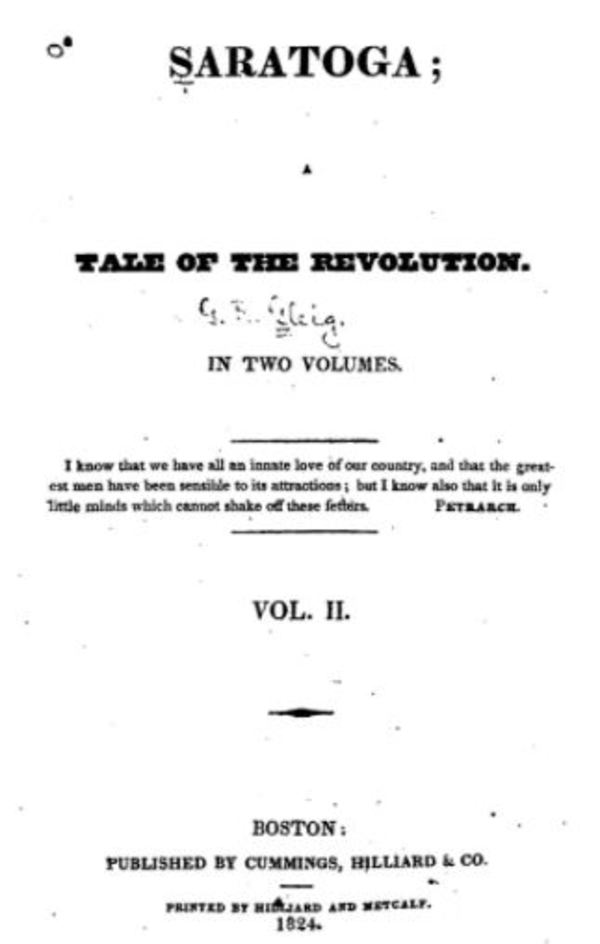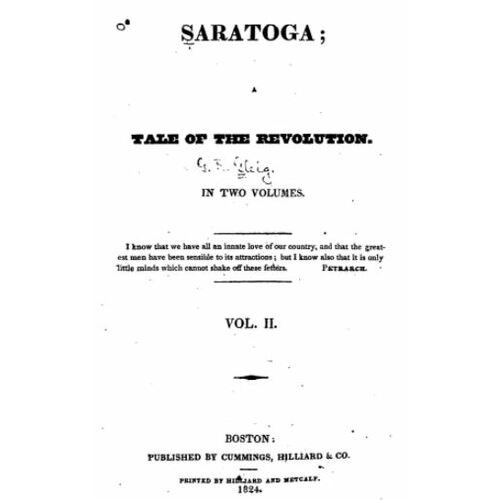
Source: Link
FOSTER, ELIZA LANESFORD (Cushing), writer and editor; b. in 1794 at Brighton, Mass., daughter of John Foster, pastor of the Congregationalist Unitarian Church in Brighton, and Hannah Webster, novelist; d. 4 May 1886 at Montreal, Que.
Before her marriage to Dr Frederick Cushing in 1828, Eliza Lanesford Foster had written two historical romances, Saratoga and Yorktown, published anonymously in Boston in the 1820s. In 1833 Eliza moved to Montreal with her husband. He established a successful medical practice in the city, but succumbed to ship-fever in 1846 while treating immigrants. Eliza Foster Cushing lived on in Montreal for 40 years. Her financial status remains a mystery: she did not move in the circles of the well-to-do, nor did she keep servants in her house; and yet she had sufficient means for the occasional lengthy trip. To an advanced age she enjoyed what she called providence’s grant of “much sound health of body and mind as permit [me] to enjoy without diminution the friendships and blessings with which he still brightens [my] later days.”
From 1838 to 1851 Eliza Foster Cushing, while also contributing regularly to magazines in the United States, wrote some 70 short stories, poems, and historical romances for the Literary Garland of Montreal. This magazine, begun in December 1838 by John Gibson and John Lovell*, was the first Canadian literary journal to survive longer than three years. Few of Mrs Cushing’s pieces have any Canadian content or interest; only one (published in Godey’s Magazine of Philadelphia) even hints that she was aware of living in exciting times in Lower Canada. But all the tales have a distinct flavour and a decided moral lesson. In the fashion of the polite literature of the day, the settings are pastoral and upper class, the activities languid; emotions abound as women swoon, blush, weep, and have palpitations while dashing young men flirt with temperamental belles but settle for self-sacrificing, principled, sweet young ladies, and dark, sinister gamblers ruin the lives of innocent women. The reading public was apparently eager for her stories. But by 1851 Mrs Cushing, now herself editor of the Garland, was forced to admit that American competition and declining public favour clearly spelled the end for what she called “the only magazine published in British North America.”
Mrs Cushing had already found another literary outlet, for in 1847 she and her sister Harriet launched the first periodical in Canada East to be devoted exclusively to children. A tiny magazine, Snow Drop was full of “amusement and instruction,” and was devoted to the “progress and improvement” of middle-and upper-class young people through short stories, poems, history and nature lessons, “conundrums,” and games. The editors invited participation from their readers but it came only from girls. Indeed girls seem to have been the object of most of the moral lessons which again imbued all the tales: they were the ones who had to learn truthfulness, reliability, goodness, obedience, filial respect, perseverance, thrift, orderliness, integrity, and self-reliance. As future guardians of the morals of their families, perhaps they did have the most to learn.
In the hopes of attracting a wider audience, Mrs Cushing expanded Snow Drop in 1850 into another series, larger and more varied. But her publisher, it seems, had grandiose plans for launching another magazine and for dislodging the two widowed sisters as editors. A new publisher, Robert W. Lay, took over in 1852, but by the following year both Snow Drop and Eliza Cushing disappear from public view.
Through the Literary Garland and the Snow Drop, Eliza Foster Cushing contributed to the tone of moralizing sentimentality in 19th-century Canadian letters, a tone that would not vanish entirely until the 1920s. The religious and moral sentiment which pervades her writings may have been inherited from her father, but her literary taste and talent undoubtedly stemmed from her mother, an early American novelist. Mrs Cushing’s literary pieces were in marked contrast to the partisan polemics of most newspapers of the 19th century. But the very existence of her work, and that of Susanna Moodie [Strickland] and Rosanna Eleanora Leprohon [Mullins*] may be taken as evidence of the growth of a leisured, apolitical, genteel (and perhaps distaff) reading public. The failure of the two periodicals to last longer suggests, however, either that the reading public was not yet large in Canada or that it preferred American and British magazines to Canadian copies of them.
Eliza Lanesford Foster (Cushing) was the author of Saratoga, a tale of the revolution (2v., Boston, 1824); Yorktown, an historical romance . . . (2v., Boston, 1826). J. S. Cushing papers are in the possession of Marjorie Harbert of Montreal.
PAC, RG 31, Al, 1871 census, Montreal, Saint-Antoine Ward: 40. Gazette (Montreal), 5 May 1886. Literary Garland (Montreal), 1838–51. Montreal Daily Star, 5 May 1886. Snow Drop; or, Juvenile Magazine (Montreal and Toronto), 1847–53. M. M. Brown, An index to the “Literary Garland,” (Montreal, 1838–1851) (Toronto, 1962), 5–6. J. S. Cushing, The genealogy of the Cushing family, an account of the ancestors and descendants of Matthew Cushing, who came to America in 1638 (Montreal, 1905), 308–9. Dominion annual register, 1886: 264. S. J. Hale, Woman’s record; or sketches of all distinguished women, from “the beginning” till A.D. 1850 (New York, 1853), 825–26. Morgan, Bibliotheca canadensis, 73. F. C. Pierce, Foster genealogy; being the record of posterity of Reginald Foster, an early inhabitant of Ipswich, in New England . . . (Chicago, 1899), 238–39. Watters, Checklist, 270, 430. J. G. Brierley, “A study of literature in English produced in the province of Quebec prior to confederation, with its historical background”
Cite This Article
Susan Mann Trofimenkoff, “FOSTER, ELIZA LANESFORD (Cushing),” in Dictionary of Canadian Biography, vol. 11, University of Toronto/Université Laval, 2003–, accessed April 28, 2025, https://www.biographi.ca/en/bio/foster_eliza_lanesford_11E.html.
The citation above shows the format for footnotes and endnotes according to the Chicago manual of style (16th edition). Information to be used in other citation formats:
| Permalink: | https://www.biographi.ca/en/bio/foster_eliza_lanesford_11E.html |
| Author of Article: | Susan Mann Trofimenkoff |
| Title of Article: | FOSTER, ELIZA LANESFORD (Cushing) |
| Publication Name: | Dictionary of Canadian Biography, vol. 11 |
| Publisher: | University of Toronto/Université Laval |
| Year of revision: | 1982 |
| Access Date: | April 28, 2025 |



